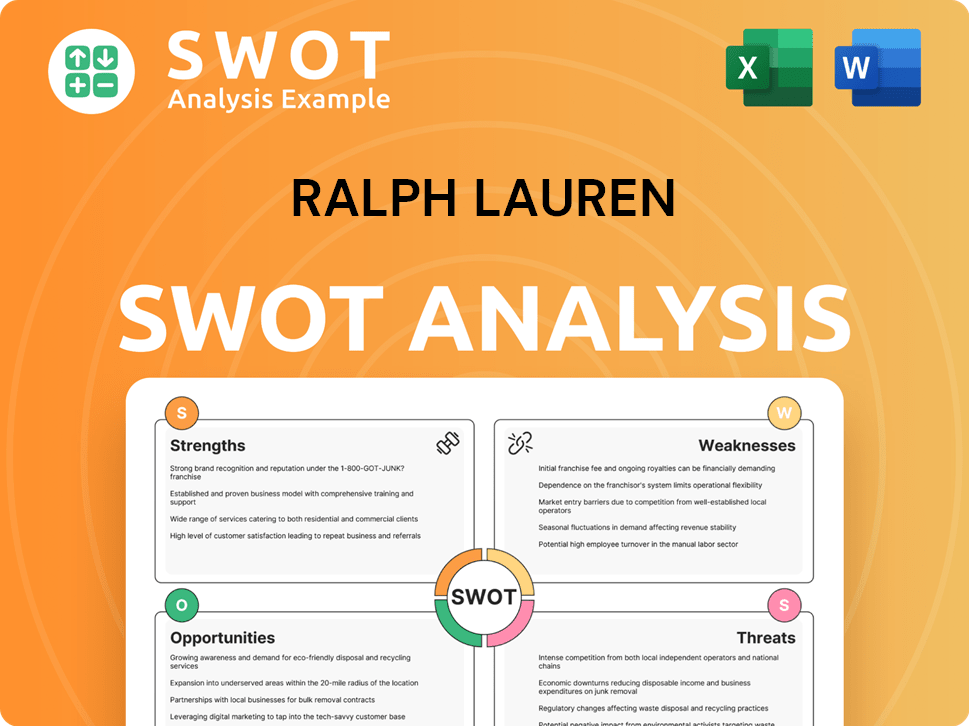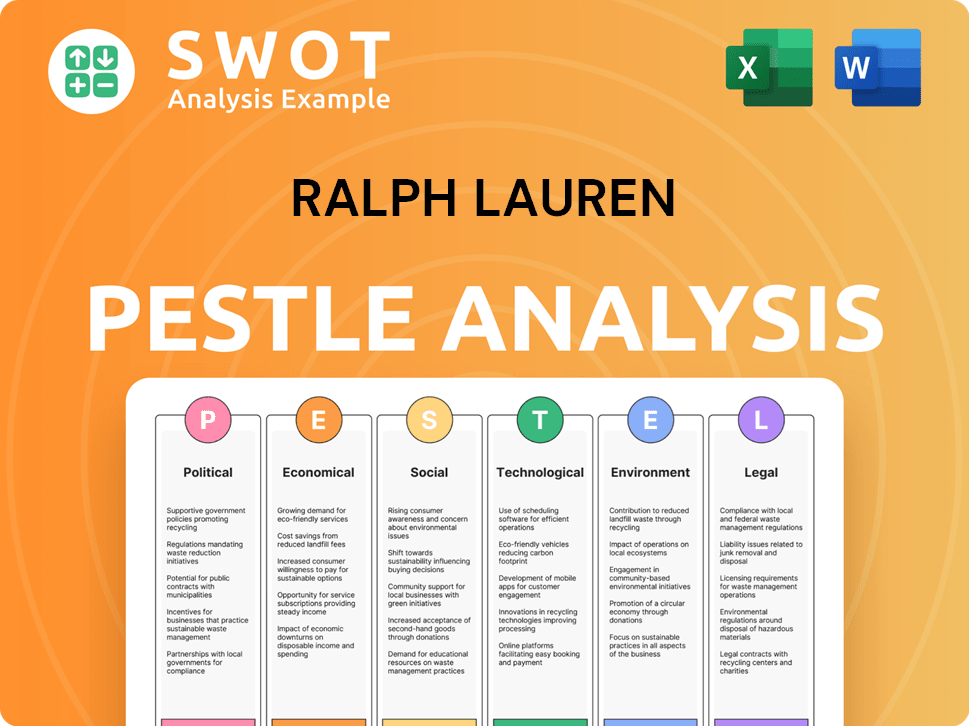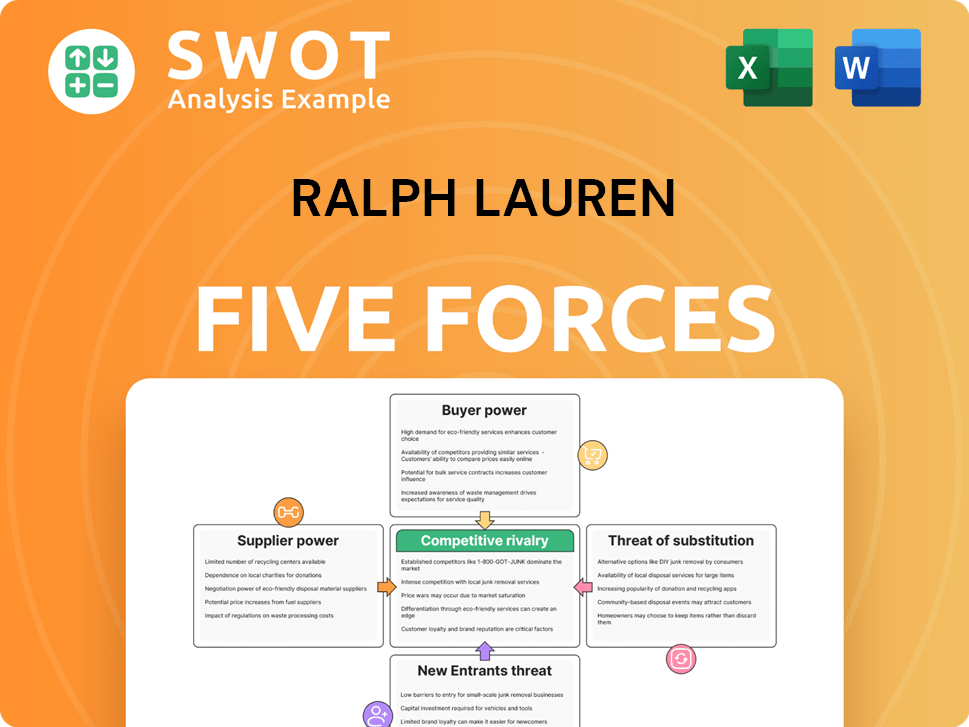Ralph Lauren Bundle
Who Really Controls the Legacy of Ralph Lauren?
The Ralph Lauren brand, synonymous with American luxury, has a fascinating ownership story that shapes its future. Understanding who owns Ralph Lauren is crucial for anyone interested in the company's strategic direction and its ability to navigate the ever-changing fashion landscape. From its humble beginnings to its current global presence, the Ralph Lauren company's ownership structure has evolved significantly.

This deep dive into Ralph Lauren ownership will explore the evolution of the company, from its founding by Ralph Lauren to its current status as a publicly traded entity. We'll examine the influence of major shareholders, the role of the Ralph Lauren SWOT Analysis, and the impact of the CEO on its overall performance. Discover the key players and their influence on the Ralph Lauren company's financials, history, and future, including the current owner of Ralph Lauren and the company's stock performance.
Who Founded Ralph Lauren?
The Ralph Lauren company, a globally recognized name in fashion and lifestyle, was founded by Ralph Lauren in 1967. Initially known as Polo Fashions, the company's inception involved a pivotal financial backing that set the stage for its future expansion. This early support, provided by Norman Hilton, was crucial in launching the brand.
Ralph Lauren's vision was the driving force behind the company's initial direction and growth. His background in the fashion industry, including experience at Brooks Brothers and as a tie designer, provided the necessary foundation. The brand's early success was built on Lauren's entrepreneurial drive and his clear vision for a comprehensive lifestyle brand.
The ownership structure at the outset was primarily centered around Ralph Lauren himself. While specific equity splits are not publicly detailed, it's understood that Ralph Lauren held the predominant ownership stake. This concentration of control allowed for agile decision-making and a strong brand identity from the start.
The early ownership of the Ralph Lauren brand was significantly shaped by Ralph Lauren's vision and control. The initial financial backing from Norman Hilton was a key element in the company's launch. The company's structure allowed for rapid decision-making and a consistent brand identity.
- Ralph Lauren founded the company in 1967, initially as Polo Fashions.
- Norman Hilton provided an early loan of $50,000, acting as initial backing.
- Ralph Lauren held the predominant ownership stake, reflecting his central role.
- His background in sales and design provided industry knowledge and creative direction.
Ralph Lauren SWOT Analysis
- Complete SWOT Breakdown
- Fully Customizable
- Editable in Excel & Word
- Professional Formatting
- Investor-Ready Format

How Has Ralph Lauren’s Ownership Changed Over Time?
The Ralph Lauren Company transitioned from a privately held entity to a publicly traded one through its initial public offering (IPO) on June 12, 1997. This IPO marked a significant milestone, enabling the company to secure capital for expansion and altering its ownership dynamics. While the exact initial market capitalization at the IPO isn't readily available, the offering introduced a wide array of public shareholders. This shift was crucial in the company's evolution, allowing it to grow and establish a stronger presence in the global market.
The evolution of the ownership structure of the Ralph Lauren brand has been shaped by key events. The IPO in 1997 was a pivotal moment, transforming the company from a private enterprise to a publicly traded one. This move allowed for increased capital and a broader shareholder base. Over time, the ownership has diversified, with institutional investors playing a major role. These changes reflect the company's growth and adaptation to the market.
| Event | Date | Impact on Ownership |
|---|---|---|
| Initial Public Offering (IPO) | June 12, 1997 | Transitioned from private to public ownership; introduced public shareholders. |
| Institutional Investment Growth | Ongoing | Increased ownership by institutional investors like The Vanguard Group and BlackRock. |
| Ralph Lauren's Continued Stake | Ongoing | Ralph Lauren maintained a significant ownership stake, ensuring founder influence. |
As of early 2025, the ownership of the Ralph Lauren company is characterized by a mix of institutional and individual investors. Major institutional investors, including The Vanguard Group and BlackRock, hold substantial shares, reflecting their confidence in the brand's long-term value. Simultaneously, Ralph Lauren himself remains a significant shareholder, often retaining a class of stock with enhanced voting rights. This structure allows the founder to maintain considerable control over strategic decisions, ensuring the company's direction aligns with his vision while operating as a publicly traded entity. This dual-class share structure is a key factor in how the company approaches long-term strategy, brand integrity, and succession planning.
The Ralph Lauren ownership structure has evolved significantly since its IPO in 1997.
- Institutional investors hold a significant portion of the shares.
- Ralph Lauren, the founder, maintains a substantial ownership stake.
- The company's ownership structure impacts its strategic direction and brand integrity.
- Understanding the ownership is crucial for investors and stakeholders.
Ralph Lauren PESTLE Analysis
- Covers All 6 PESTLE Categories
- No Research Needed – Save Hours of Work
- Built by Experts, Trusted by Consultants
- Instant Download, Ready to Use
- 100% Editable, Fully Customizable

Who Sits on Ralph Lauren’s Board?
The Board of Directors of the Ralph Lauren Corporation, as of early 2025, oversees the company's operations, balancing the interests of various stakeholders. The board includes a mix of independent directors, representatives of major shareholders, and the founder, Ralph Lauren. Ralph Lauren, serving as Executive Chairman and Chief Creative Officer, maintains a central role in both the board and the company's creative direction. His continued presence on the board reflects his significant ownership stake and special voting rights, which are key aspects of understanding who owns Ralph Lauren.
The composition of the board ensures a blend of experience and perspectives. Independent directors provide oversight and contribute to corporate governance, while the founder's presence ensures the brand's vision remains central. Institutional investors also influence governance through shareholder proposals and direct dialogue. Understanding the board's structure is critical to grasping the dynamics of the Ralph Lauren brand and its strategic direction. The Growth Strategy of Ralph Lauren highlights how leadership and ownership shape the company's future.
| Board Member | Title | Role |
|---|---|---|
| Ralph Lauren | Executive Chairman & Chief Creative Officer | Oversees company's strategic direction and creative vision. |
| Patrice Louvet | President and CEO | Manages day-to-day operations and strategic initiatives. |
| Valerie B. Jarrett | Director | Provides independent oversight and governance expertise. |
The company operates with a dual-class share structure, significantly impacting voting power. Class A common stock, held by the public and institutional investors, carries one vote per share. Class B common stock, primarily held by Ralph Lauren, carries multiple votes per share. This structure grants Ralph Lauren disproportionate voting control, ensuring his strategic vision and brand integrity remain paramount. This is a critical factor in understanding the Ralph Lauren ownership structure.
Ralph Lauren's dual-class share structure gives him significant voting power.
- The board includes independent directors, Ralph Lauren, and representatives of major shareholders.
- Ralph Lauren's role as Executive Chairman and Chief Creative Officer ensures his influence.
- Institutional investors engage with the board through various channels.
- The ownership structure ensures brand vision and strategic direction remain paramount.
Ralph Lauren Business Model Canvas
- Complete 9-Block Business Model Canvas
- Effortlessly Communicate Your Business Strategy
- Investor-Ready BMC Format
- 100% Editable and Customizable
- Clear and Structured Layout

What Recent Changes Have Shaped Ralph Lauren’s Ownership Landscape?
Over the past few years, the ownership landscape of the Ralph Lauren company has seen some key trends. The company has consistently used share buyback programs to return value to its shareholders. For example, in fiscal year 2024, the company continued repurchasing shares, aiming to optimize its capital structure and increase shareholder value. These actions reduce the number of outstanding shares, potentially increasing earnings per share.
While there haven't been major changes like large-scale mergers or acquisitions that have drastically altered the ownership profile, the company has focused on strategic brand management and targeted investments. Leadership changes have occurred, but Ralph Lauren's continued role as Executive Chairman and Chief Creative Officer ensures continuity in strategic vision. There have been no public announcements regarding his immediate departure or significant changes to his controlling stake. The Ralph Lauren brand remains a significant player in the fashion industry.
| Ownership Trend | Details | Impact |
|---|---|---|
| Share Buybacks | Ongoing share repurchase programs. | Reduces outstanding shares, potentially increasing earnings per share. |
| Institutional Investors | Increasing influence of large index funds and actively managed funds. | Reflects broader market dynamics and investment strategies. |
| Founder's Role | Ralph Lauren's enduring role as Executive Chairman and Chief Creative Officer. | Ensures continuity in strategic vision. |
Industry trends, such as the increasing influence of institutional investors, are evident in Ralph Lauren's shareholder base. The company's public statements and analyst coverage focus on brand elevation, digital transformation, and global expansion. The Ralph Lauren company ownership structure is also influenced by its founder. The dual-class share structure helps to preserve Ralph Lauren's voting power. To understand the Ralph Lauren company mission statement and values, you can explore the Target Market of Ralph Lauren article.
Share buybacks are a key part of the company's strategy. These buybacks reduce the number of shares available. This can increase the value of the remaining shares.
Institutional investors are a significant part of the shareholder base. These investors often adjust their holdings based on market performance. This reflects broader market trends.
Ralph Lauren's role remains central to the company's vision. His continued involvement provides stability and direction. This ensures continuity in strategic vision.
The company focuses on brand elevation and global expansion. Digital transformation is also a key area of focus. These strategies drive growth.
Ralph Lauren Porter's Five Forces Analysis
- Covers All 5 Competitive Forces in Detail
- Structured for Consultants, Students, and Founders
- 100% Editable in Microsoft Word & Excel
- Instant Digital Download – Use Immediately
- Compatible with Mac & PC – Fully Unlocked

Related Blogs
- What are Mission Vision & Core Values of Ralph Lauren Company?
- What is Competitive Landscape of Ralph Lauren Company?
- What is Growth Strategy and Future Prospects of Ralph Lauren Company?
- How Does Ralph Lauren Company Work?
- What is Sales and Marketing Strategy of Ralph Lauren Company?
- What is Brief History of Ralph Lauren Company?
- What is Customer Demographics and Target Market of Ralph Lauren Company?
Disclaimer
All information, articles, and product details provided on this website are for general informational and educational purposes only. We do not claim any ownership over, nor do we intend to infringe upon, any trademarks, copyrights, logos, brand names, or other intellectual property mentioned or depicted on this site. Such intellectual property remains the property of its respective owners, and any references here are made solely for identification or informational purposes, without implying any affiliation, endorsement, or partnership.
We make no representations or warranties, express or implied, regarding the accuracy, completeness, or suitability of any content or products presented. Nothing on this website should be construed as legal, tax, investment, financial, medical, or other professional advice. In addition, no part of this site—including articles or product references—constitutes a solicitation, recommendation, endorsement, advertisement, or offer to buy or sell any securities, franchises, or other financial instruments, particularly in jurisdictions where such activity would be unlawful.
All content is of a general nature and may not address the specific circumstances of any individual or entity. It is not a substitute for professional advice or services. Any actions you take based on the information provided here are strictly at your own risk. You accept full responsibility for any decisions or outcomes arising from your use of this website and agree to release us from any liability in connection with your use of, or reliance upon, the content or products found herein.